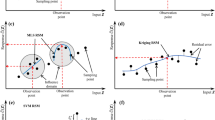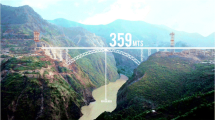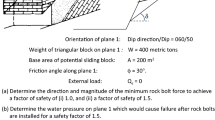Abstract
While advanced numerical techniques in slope stability analysis are successfully used in deterministic studies, they have so far found limited use in probabilistic analyses due to their high computation cost. The first-order reliability method (FORM) is one of the most efficient probabilistic techniques to perform probabilistic stability analysis by considering the associated uncertainties in the analysis parameters. However, it is not possible to directly use FORM in numerical slope stability evaluations as it requires definition of a limit state performance function. In this study, an integrated methodology for probabilistic numerical modeling of rock slope stability is proposed. The methodology is based on response surface method, where FORM is used to develop an explicit performance function from the results of numerical simulations. The implementation of the proposed methodology is performed by considering a large potential rock wedge in Sumela Monastery, Turkey. The accuracy of the developed performance function to truly represent the limit state surface is evaluated by monitoring the slope behavior. The calculated probability of failure is compared with Monte Carlo simulation (MCS) method. The proposed methodology is found to be 72% more efficient than MCS, while the accuracy is decreased with an error of 24%.










Similar content being viewed by others
References
Ang AHS, Tang WH (1984) Probability concepts in engineering planning and design. Decision, risk, and reliability, vol 2. Wiley, New York
Anon (2013) 3DEC Three-Dimensional Distinct Element Code V.5.0, User’s Manual. Itasca Consulting Group Inc
Bieniawski ZT (1989) Engineering rock mass classifications. Wiley, New York
Box G, Draper NR (1987) Empirical model building and response surface. Willey, New York
Box GEP, Wilson KB (1951) On the experimental attainment of optimum conditions. J R Stat Soc 13:1–45
Bucher CG, Bourgund YM (1990) A fast and efficient response surface approach for structural reliability problems. Struct Saf 7:57–66
Cundall P (1971) A computer model for simulating progressive, large scale movements in blocky rock systems. In: Proceedings of the international symposium rock fracture, ISRM. Paper No. II-8
Diederichs MS, Lato M, Quinn P, Hammah R (2007) Shear strength reduction approach for slope stability analyses. In: 1st Canada–US rock mechanics symposium
Duzgun HSB, Bhasin RK (2008) Probabilistic stability evaluation of Oppstadhornet rock slope, Norway. Rock Mech Rock Eng 42:729–749. doi:10.1007/s00603-008-0011-3
Duzgun HSB, Yucemen MS, Karpuz C (2003) A methodology for reliability-based design of rock slopes. Rock Mech Rock Eng 36:95–120. doi:10.1007/s00603-002-0034-0
Eberhardt E, Stead D, Coggan JS (2004) Numerical analysis of initiation and progressive failure in natural rock slopes—the 1991 Randa rockslide. Int J Rock Mech Min Sci 41:69–87. doi:10.1016/S1365-1609(03)00076-5
Faravelli L (1989) Response surface approach for reliability analysis. Eng Mech 115:2763–2781
Fiessler B, Rackwitz R (1979) Quadratic limit states in structural reliability. J Eng Mech Div 105:661–676
Firpo G, Salvini R, Francioni M, Ranjith PG (2011) Use of digital terrestrial photogrammetry in rocky slope stability analysis by distinct elements numerical methods. Int J Rock Mech Min Sci 48:1045–1054. doi:10.1016/j.ijrmms.2011.07.007
Gelisli K, Seren A, Babacan AE et al (2011) The Sumela Monastery slope in Macka, Trabzon, Northeast Turkey: rock mass properties and stability assessment. Bull Eng Geol Environ 70:577–583. doi:10.1007/s10064-010-0343-6
Griffiths DV, Lane PA (1999) Slope stability analysis by finite element. J Geotech 49:387–403
Haderbache L, Laouami N (2013) A new rapid approach in assessing slope stability beneath a random field. Indian J Geo-Mar Sci 42(6):734–744
Hasofer AM, Lind NC (1974) Exact and invariant second-moment code format. J Eng Mech Div 100:111–121
Itasca (2013) 3DEC Three-Dimensional Distinct Element Code V.5.0. Itasca Consulting Group Inc
Ji J, Low BK (2012) Stratified response surfaces for system probabilistic evaluation of slopes. J Geotech Geoenviron Eng 138:1398–1406. doi:10.1061/(ASCE)GT.1943-5606.0000711
Jimenez-Rodriguez R, Sitar N, Chacón J (2006) System reliability approach to rock slope stability. Int J Rock Mech Min Sci 43:847–859. doi:10.1016/j.ijrmms.2005.11.011
Johari A, Lari AM (2016) System reliability analysis of rock wedge stability considering correlated failure modes using sequential compounding method. Int J Rock Mech Min Sci 82:61–70
Kainthola A, Verma D, Thareja R, Singh TN (2013) A review on numerical slope stability analysis. Int J Sci Eng Technol Res 2(6):1315–1320
Khuri AI, Mukhopadhyay S (2010) Response surface methodology. WIREs. Comput Stat 2:128–149. doi:10.1002/wics.73
Kim SH, Na SW (1997) Response surface method using vector projected sampling points. Struct Saf 19:3–19
Li D, Zhou C, Lu W, Jiang Q (2009) A system reliability approach for evaluating stability of rock wedges with correlated failure modes. Comput Geotech 36:1298–1307. doi:10.1016/j.compgeo.2009.05.013
Li D-Q, Jiang S-H, Cao Z-J et al (2015) A multiple response-surface method for slope reliability analysis considering spatial variability of soil properties. Eng Geol 187:60–72. doi:10.1016/j.enggeo.2014.12.003
Li D-Q, Zheng D, Cao Z-J, Tang XS, Phoon KK (2016) Response surface methods for slope reliability analysis: review and comparison. Eng Geol 203:3–14
Liu LL, Cheng YM (2016) Efficient system reliability analysis of soil slopes using multivariate adaptive regression splines-based Monte Carlo simulation. Comput Geotech 79:41–54
Liu YW, Moses F (1994) A sequential response surface method and its application in the reliability analysis of aircraft structural systems. Struct Saf 16:39–46
Miller W (1968) Trebizond: the last Greek empire. The Macmillan co, London
Montgomery DC (1997) Design and analysis of experiments. Wiley, New York
Myers RH, Montgomery DC (1995) Response surface methodology: process and product optimization using designed experiments. Wiley, New York
Nataf A (1962) Determination des distribution dont les marges sont donnees. C R lacademie des Sci 225:42–43
Rajashekhar M, Ellingwood B (1993) A new look at the response surface approach for reliability analysis. Struct Saf 12:205–220. doi:10.1016/0167-4730(93)90003
Rocscience (2015) Dips, V.6.016. Toronto, Canada
Rosenblatt M (1952) Remarks on a multivariate transformation. Ann Math Stat 23:470–472
Schultz RA (1993) Brittle strength of basaltic rock masses with applications to Venus. J Geophys Res 98(E6):10883
Shen H (2012) Non-deterministic analysis of slope stability based on numerical simulation. Technische Universität Bergakademie, Freiberg
Stead D, Eberhardt E (1997) Developments in the analysis of footwall slopes in surface coal mining. Eng Geol 46:41–61. doi:10.1016/S0013-7952(96)00084-1
Wong F (1985) Slope reliability and response surface method. Geotech Eng 111:32–53
Youliang D, Aiqun L, Yang D (2008) A new look at the response surface method for reliability analysis using chaos theory. Earthq Eng Eng Vib 7:329–335. doi:10.1007/s11803-008-0852-5
Zangeneh N, Azizian A, Lye L, Popescu R (2002) Application of response surface methodology in numerical geotechnical analysis. In: 55th Canadian Society for geotechnical conference, Hamilton, ON
Zhang J, Du X (2010) A second-order reliability method with first-order efficiency. J Mech Des 132:101006
Zhang J, Huang HW, Phoon KK (2013) Application of the Kriging-based response surface method to the system reliability of soil slopes. J Geotech Geoenviron Eng 139:651–655. doi:10.1061/(ASCE)GT.1943-5606.0000801
Zheng Y, Das P (2000) Improved response surface method and its application to stiffened plate reliability analysis. Eng Struct 22:544–551. doi:10.1016/S0141-0296(98)00136-9
Acknowledgements
The data related to the case study were obtained from the project (No: 114M015) funded by The Scientific and Technological Research Council of Turkey. The authors acknowledge the funding as well as the project researchers for their invaluable help during data collection. The authors also thank to Cagdas Caglayan from Directorate of Surveying and Monuments of Trabzon, Republic of Turkey, Ministry of Culture and Tourism, for his help during the field studies.
Author information
Authors and Affiliations
Corresponding author
Rights and permissions
About this article
Cite this article
Dadashzadeh, N., Duzgun, H.S.B. & Yesiloglu-Gultekin, N. Reliability-Based Stability Analysis of Rock Slopes Using Numerical Analysis and Response Surface Method. Rock Mech Rock Eng 50, 2119–2133 (2017). https://doi.org/10.1007/s00603-017-1206-2
Received:
Accepted:
Published:
Issue Date:
DOI: https://doi.org/10.1007/s00603-017-1206-2




